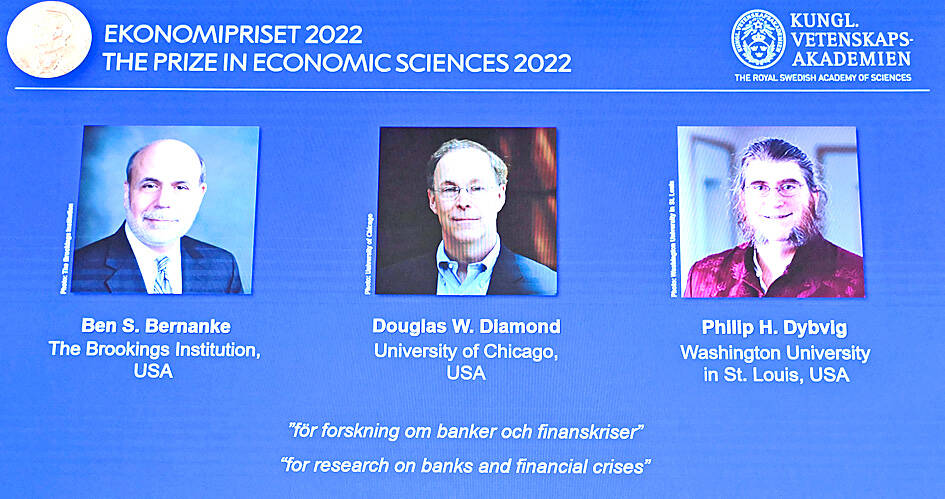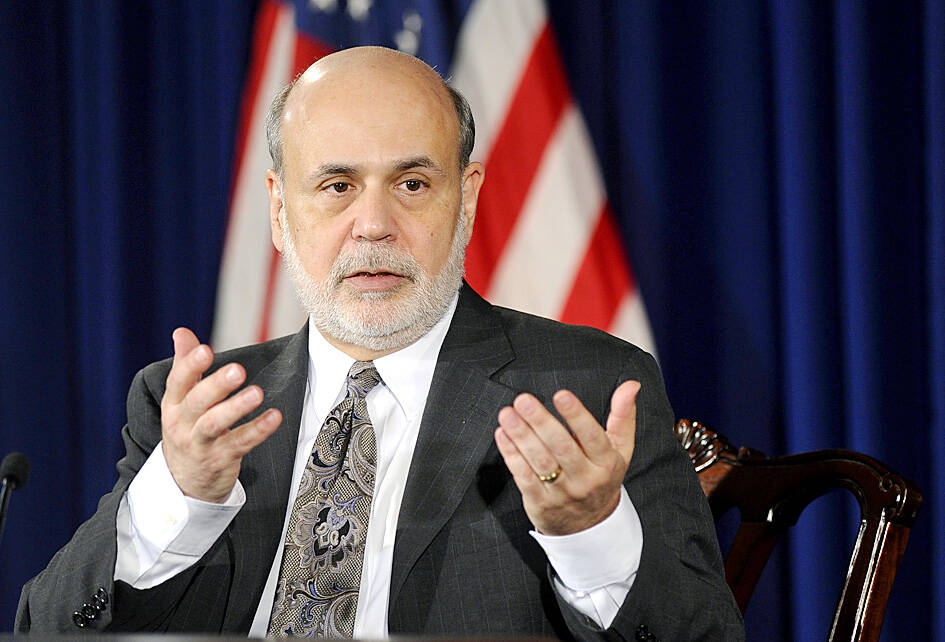This year’s Nobel Prize in Economic Sciences has been awarded to former US Federal Reserve chair Ben Bernanke and two US-based economists, Douglas Diamond and Philip Dybvig, “for research on banks and financial crises.”
The prize was announced yesterday by the Nobel panel at the Royal Swedish Academy of Sciences in Stockholm.
The committee said their work had shown in their research “why avoiding bank collapses is vital.”

Photo: AFP
With their research in the early 1980s, the laureates laid the foundations for regulating financial markets and dealing with financial crises, the panel said.
Bernanke, 68, who is now with the Brookings Institution in Washington, examined the Great Depression of the 1930s, showing how dangerous bank runs — when panicked savers withdraw their deposits — can be.
Diamond, 68, based at the University of Chicago, and Dybvig, 67, who is at Washington University in St Louis, showed how government guarantees on deposits can prevent a spiraling of financial crises.

Photo: AP
“The laureates’ insights have improved our ability to avoid both serious crises and expensive bailouts,” said Tore Ellingsen, chair of the Committee for the Prize in Economic Sciences.
Their research took on great real-world significance when investors sent the financial system into a panic during the fall of 2008.
Bernanke, then head of the Fed, teamed up with the US Department of the Treasury to prop up major banks and ease a shortage of credit, the lifeblood of the economy.
He slashed short-term interest rates to zero, directed the Fed’s purchases of Treasury and mortgage investments and set up unprecedented lending programs. Collectively, those steps calmed investors and fortified big banks.
They also pushed long-term interest rates to historic lows and led to fierce criticism of Bernanke, particularly from some 2012 Republican presidential candidates, that the Fed was hurting the value of the US dollar and running the risk of igniting inflation later.
The Fed’s actions under Bernanke extended the authority of the central bank into unprecedented territory. They were not able to prevent the longest and most painful recession since the 1930s.
However, in hindsight, the Fed’s moves were credited with rescuing the banking system and avoiding another depression.
By honoring Bernanke, the prize committee have taken an unusual step of adding an actual practitioner of economic policy to their pantheon. By contrast, many prior winners have stayed firmly rooted in academia.
That is illustrated by the widespread list of research areas celebrated in the past decade. They range from the integration of climate change and technological innovations into economics in 2018, to studies involving global poverty and auction theory in successive years.
“Prior to Bernanke’s study, the general perception was that the banking crisis was a consequence of a declining economy, rather than a cause of it,” the committee said. “Bernanke established that bank collapses were decisive for the recession developing into deep and prolonged depression. Bernanke demonstrated that the economy did not start to recover until the state finally implemented powerful measures to prevent additional bank panics.”
Nobel prizes carry a cash award of 10 million Swedish kronor (US$884,721), which is to be handed out on Dec. 10.
Unlike the other prizes, the economics award was not established in Alfred Nobel’s will of 1895, but by the Swedish central bank in his memory. The first winner was selected in 1969.
Last year, half of the award went to David Card for his research on how the minimum wage, immigration and education affect the labor market. The other half was shared by Joshua Angrist and Guido Imbens for proposing how to study issues that do not easily fit traditional scientific methods.
Additional reporting by Bloomberg

UPDATED (3:40pm): A suspected gas explosion at a shopping mall in Taichung this morning has killed four people and injured 20 others, as emergency responders continue to investigate. The explosion occurred on the 12th floor of the Shin Kong Mitsukoshi in Situn District (西屯) at 11:33am. One person was declared dead at the scene, while three people were declared deceased later after receiving emergency treatment. Another 20 people sustained major or minor injuries. The Taichung Fire Bureau said it received a report of the explosion at 11:33am and sent rescuers to respond. The cause of the explosion is still under investigation, it said. The National Fire

ACCOUNTABILITY: The incident, which occured at a Shin Kong Mitsukoshi Department Store in Taichung, was allegedly caused by a gas explosion on the 12th floor Shin Kong Group (新光集團) president Richard Wu (吳昕陽) yesterday said the company would take responsibility for an apparent gas explosion that resulted in four deaths and 26 injuries at Shin Kong Mitsukoshi Zhonggang Store in Taichung yesterday. The Taichung Fire Bureau at 11:33am yesterday received a report saying that people were injured after an explosion at the department store on Section 3 of Taiwan Boulevard in Taichung’s Situn District (西屯). It sent 56 ambulances and 136 paramedics to the site, with the people injured sent to Cheng Ching Hospital’s Chung Kang Branch, Wuri Lin Shin Hospital, Taichung Veterans General Hospital or Chung

ALL-IN-ONE: A company in Tainan and another in New Taipei City offer tours to China during which Taiwanese can apply for a Chinese ID card, the source said The National Immigration Agency and national security authorities have identified at least five companies that help Taiwanese apply for Chinese identification cards while traveling in China, a source said yesterday. The issue has garnered attention in the past few months after YouTuber “Pa Chiung” (八炯) said that there are companies in Taiwan that help Taiwanese apply for Chinese documents. Minister of the Interior Liu Shyh-fang (劉世芳) last week said that three to five public relations firms in southern and northern Taiwan have allegedly assisted Taiwanese in applying for Chinese ID cards and were under investigation for potential contraventions of the Act Governing

‘LAWFUL USE’: The last time a US warship transited the Taiwan Strait was on Oct. 20 last year, and this week’s transit is the first of US President Donald Trump’s second term Two US military vessels transited the Taiwan Strait from Sunday through early yesterday, the Ministry of National Defense said in a statement, the first such mission since US President Donald Trump took office last month. The two vessels sailed south through the Strait, the ministry said, adding that it closely monitored nearby airspace and waters at the time and observed nothing unusual. The ministry did not name the two vessels, but the US Navy identified them as the Arleigh Burke-class guided-missile destroyer USS Ralph Johnson and the Pathfinder-class survey ship USNS Bowditch. The ships carried out a north-to-south transit from